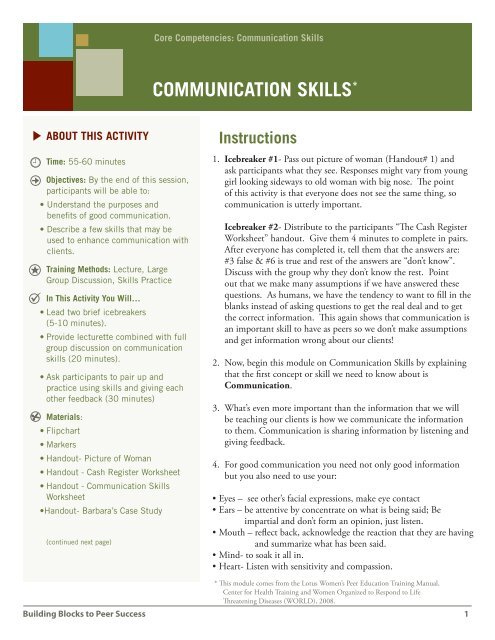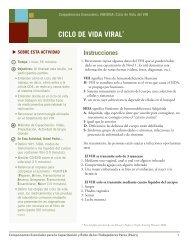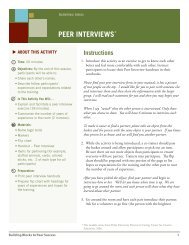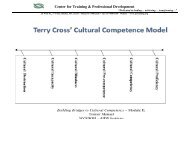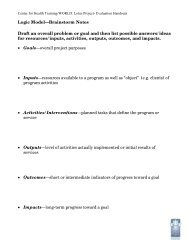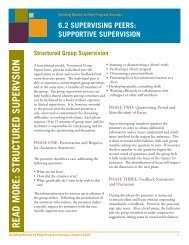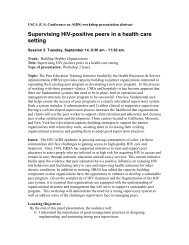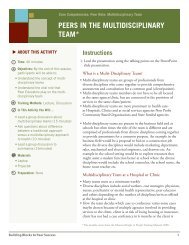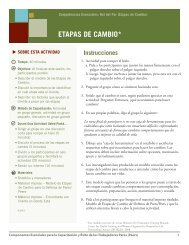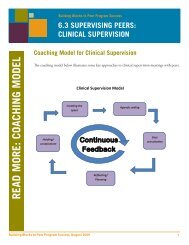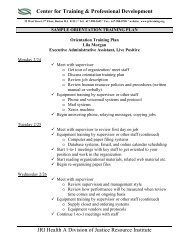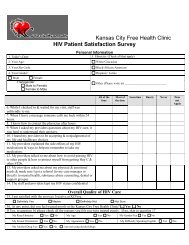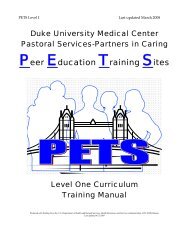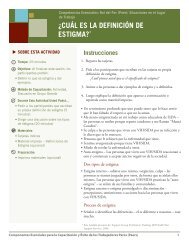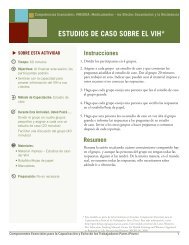Communication Skills - Peer Education & Evaluation Resource Center
Communication Skills - Peer Education & Evaluation Resource Center
Communication Skills - Peer Education & Evaluation Resource Center
You also want an ePaper? Increase the reach of your titles
YUMPU automatically turns print PDFs into web optimized ePapers that Google loves.
Core Competencies: <strong>Communication</strong> <strong>Skills</strong><br />
COMMUNICATION SKILLS *<br />
ABOUT THIS ACTIVITY<br />
Time: 55-60 minutes<br />
Objectives: By the end of this session,<br />
participants will be able to:<br />
• Understand the purposes and<br />
benefits of good communication.<br />
• Describe a few skills that may be<br />
used to enhance communication with<br />
clients.<br />
Training Methods: Lecture, Large<br />
Group Discussion, <strong>Skills</strong> Practice<br />
In This Activity You Will…<br />
• Lead two brief icebreakers<br />
(5-10 minutes).<br />
• Provide lecturette combined with full<br />
group discussion on communication<br />
skills (20 minutes).<br />
• Ask participants to pair up and<br />
practice using skills and giving each<br />
other feedback (30 minutes)<br />
Materials:<br />
• Flipchart<br />
• Markers<br />
• Handout- Picture of Woman<br />
• Handout - Cash Register Worksheet<br />
• Handout - <strong>Communication</strong> <strong>Skills</strong><br />
Worksheet<br />
•Handout- Barbara’s Case Study<br />
(continued next page)<br />
Instructions<br />
1. Icebreaker #1- Pass out picture of woman (Handout# 1) and<br />
ask participants what they see. Responses might vary from young<br />
girl looking sideways to old woman with big nose. The point<br />
of this activity is that everyone does not see the same thing, so<br />
communication is utterly important.<br />
Icebreaker #2- Distribute to the participants “The Cash Register<br />
Worksheet” handout. Give them 4 minutes to complete in pairs.<br />
After everyone has completed it, tell them that the answers are:<br />
#3 false & #6 is true and rest of the answers are “don’t know”.<br />
Discuss with the group why they don’t know the rest. Point<br />
out that we make many assumptions if we have answered these<br />
questions. As humans, we have the tendency to want to fill in the<br />
blanks instead of asking questions to get the real deal and to get<br />
the correct information. This again shows that communication is<br />
an important skill to have as peers so we don’t make assumptions<br />
and get information wrong about our clients!<br />
2. Now, begin this module on <strong>Communication</strong> <strong>Skills</strong> by explaining<br />
that the first concept or skill we need to know about is<br />
<strong>Communication</strong>.<br />
3. What’s even more important than the information that we will<br />
be teaching our clients is how we communicate the information<br />
to them. <strong>Communication</strong> is sharing information by listening and<br />
giving feedback.<br />
4. For good communication you need not only good information<br />
but you also need to use your:<br />
• Eyes – see other’s facial expressions, make eye contact<br />
• Ears – be attentive by concentrate on what is being said; Be<br />
impartial and don’t form an opinion, just listen.<br />
• Mouth – reflect back, acknowledge the reaction that they are having<br />
and summarize what has been said.<br />
• Mind- to soak it all in.<br />
• Heart- Listen with sensitivity and compassion.<br />
* Tis module comes from the Lotus Women’s <strong>Peer</strong> <strong>Education</strong> Training Manual,<br />
<strong>Center</strong> for Health Training and Women Organized to Respond to Life<br />
Treatening Diseases (WORLD), 2008.<br />
Building Blocks to <strong>Peer</strong> Success 1
COMMUNICATION SKILLS<br />
ABOUT THIS ACTIVITY (CONT.)<br />
Preparation:<br />
• Make copies of handouts.<br />
• Write the following skills and their<br />
definitions on flipchart paper. Power<br />
point can also be used:<br />
<strong>Communication</strong> <strong>Skills</strong>:<br />
Affirming<br />
Open ended questions<br />
Active Listening<br />
Nonverbal Messages<br />
Express Thoughts and Feelings<br />
Communicate Without Making Other<br />
Feel “Wrong”<br />
• Go to the Case Study section of<br />
the Toolkit and print out copies of<br />
Barbara’s case study.<br />
5. Refer to the handout on <strong>Communication</strong> <strong>Skills</strong>. Tell the group<br />
we’re going to look at 6 specific communication skills that we<br />
can use in any situation, with anyone.<br />
6. As we go along, encourage the participants to complete their<br />
worksheet.<br />
7. The first communication skill is Affirming.<br />
8. Ask: what does “affirming” mean Allow 1-2 responses.<br />
9. Affirming is a positive confirmation. When you affirm<br />
something that someone has done or said, you are providing<br />
them with support and encouragement. This is unbelievably<br />
simple, yet most of us forget to do it!<br />
10. Ask: What are some examples of affirming statements Allow 3-4<br />
responses and write on flipchart.<br />
• “Tat’s good.”<br />
• “I’m glad you asked that.”<br />
• “You’ve come to the right place.”<br />
• “Tat’s a great question.”<br />
• “You’re on the right track.”<br />
• “You really seem to have given this a lot of thought.”<br />
11. The second skill is Open-ended Questions. Ask: What’s an<br />
open-ended question<br />
12. Open-ended questions are questions that can’t be answered by “yes”<br />
or “no.” Why are they useful We get much more information<br />
from people; participants “own” the information they’re<br />
learning; powerful teaching tool.<br />
13. Ask: What are some examples of open-ended questions that you<br />
would use when getting to know someone and where they come<br />
from As participants come up with questions, if they ask a<br />
closed question, simply answer “yes” or “no” and move on.<br />
Building Blocks to <strong>Peer</strong> Success 2
COMMUNICATION SKILLS<br />
14. When they come up with open-ended questions,<br />
write the first word on flipchart, until you have<br />
the following list:<br />
• When<br />
• Where<br />
• How<br />
• Who<br />
• Why<br />
• Tell me more … also counts even though it’s not<br />
really a question, it still gets more information.<br />
15. Tell participants that these are all words that<br />
open-ended questions usually begin with.<br />
16. What are some terms we should stay away from<br />
because they will give us yes or no responses and<br />
very little information<br />
• Could you<br />
• Would you<br />
• Should I<br />
• Can you<br />
• Do you<br />
• Are you<br />
17. The next skill is Active Listening.<br />
18. What do you think it means to listen actively<br />
Using your eyes, ears, mouth, heart and body<br />
language to listen. This is especially important<br />
if someone is showing some strong feelings<br />
including feeling of sadness, shock, anger, relief,<br />
frustration, grief, etc.<br />
19. Ask: if a client is having one (ore more) of these<br />
feelings, how much do you think she can learn Not<br />
much at all. So what can we do to help her let go<br />
of these feelings, so that she can be more open<br />
20. Tell the group: One thing that’s really simple and really<br />
effective is to just name the feeling, by saying something<br />
like, “you seem ______ (upset/frustrated/sad)” etc. By<br />
simply naming the feeling, it does help that person to<br />
let go and move on.<br />
21. Ask: Why does this work We let the person know its<br />
okay to have feelings; we give permission to express<br />
them and often to let them go, so she can hear the<br />
information she came to get.<br />
22. Ask: So why is it hard to actively listen We tend to<br />
want to “fix” it if someone is having uncomfortable<br />
feelings.<br />
23. The next skill is Nonverbal Messages. Ask: what are<br />
nonverbal messages<br />
• Posture - let your body show that you are interested by<br />
sitting up and leaning toward the speaker.<br />
• Equal positioning - if the speaker is standing, you stand.<br />
If the speaker is sitting, you sit as well.<br />
• Facial expression - remember that feelings are reflected<br />
in facial expressions.<br />
• Gestures - your body language reveals a lot about how<br />
you interpret a message, so be aware of when you send<br />
signals that might cause the speaker to believe that you<br />
are angry, in a hurry, bored, etc.<br />
24. It is also important to remember that different<br />
cultures have different styles of body language. For<br />
example in many cultures it is rude to give eye<br />
contact to someone who is older than you.<br />
Building Blocks to <strong>Peer</strong> Success 3
COMMUNICATION SKILLS<br />
25. The next skill is Express Thoughts and<br />
Feelings. Ask: How do we do that<br />
• Be open and honest – this will help build trust.<br />
• Speak clearly - don’t mumble and don’t talk too<br />
quietly. If you don’t know the word for something,<br />
describe what you mean so that you and the client<br />
can have a shared understanding of your concern<br />
or question.<br />
• Make the distinction between facts, beliefs, and<br />
feelings. For example, which of the following<br />
statements are which<br />
“Te best medical regimen for all clients is …”<br />
(belief)<br />
“I’m so pleased you’ve been taking your meds.”<br />
(feeling)<br />
“Most PLWH experience …” (fact)<br />
26. The last skill is to communicate without<br />
making other feel “Wrong”. How do we do<br />
this<br />
• Express concerns non-judgmentally - talk about<br />
your questions or concerns without blaming other<br />
people. For example, you might be angry that<br />
your client stood you up three times in a row.<br />
Rather than talk about her being irresponsible,<br />
you can ask her what stopped her from showing<br />
up.<br />
27. Now we are going to practice some of these skills.<br />
28. Break up group into pairs. Using Barbara’s case study<br />
as a skit, ask each pair to practice each of the following<br />
communication skills with your partner. One person is<br />
Barbara and one person is Sonya.<br />
29. Barbara will talk to Sonya to get more information<br />
about her situation and how she might go about<br />
helping her. Give pairs 20 minutes. Ask them to<br />
switch roles 10 minutes into the exercise.<br />
• Ask open ended questions.<br />
• Respond with affirming statements.<br />
• Active Listening- Reflect back what the person said.<br />
• Nonverbal Messages<br />
• Express Toughts and Feelings<br />
• Communicate without making the other feel wrong.<br />
30. Sonya should give feedback to Barbara about her use<br />
of the communication skills. 5 minutes<br />
31. Have the pairs report back on how easy or difficult it<br />
was to use the communication skills.<br />
Summary<br />
• Using these skills will feel artificial and awkward at first,<br />
but with practice, they come more easily.<br />
• Practice, practice, practice! Practicing with children is<br />
great, since you’re less likely to be self-conscious.<br />
• Use “I” statements. Rather than say, “You didn’t<br />
explain that very well,” say, “I didn’t understand<br />
what you just said. Please explain it again.”<br />
* Tis module is part of the online toolkit Building Blocks to <strong>Peer</strong> Success. For more<br />
information, visit http://www.hdwg.org/peer_center/training_toolkit.<br />
Tis module comes from the Lotus Women’s <strong>Peer</strong> <strong>Education</strong> Training Manual, <strong>Center</strong><br />
for Health Training and Women Organized to Respond to Life Treatening Diseases<br />
(WORLD), 2008.<br />
Building Blocks to <strong>Peer</strong> Success 4
COMMUNICATION SKILLS<br />
ICEBREAKER #1 PICTURE<br />
SESSION HANDOUT #1 of 3<br />
Building Blocks to <strong>Peer</strong> Success 5
COMMUNICATION SKILLS<br />
CASH REGISTER WORKSHEET<br />
SESSION HANDOUT #2 of 3<br />
The Story<br />
A businessman has just turned off the lights in the store when a man appeared and demanded<br />
money. The owner opened a cash register. The contents of the cash register were scooped up, and the<br />
man sped away. A member of the police force was notified promptly.<br />
Statements About the Story<br />
1. A man appeared after the owner turned off his T F <br />
store lights.<br />
2. Te robber was a man. T F <br />
3. Te man did not demand money. T F <br />
4. Te man who opened the cash register was T F <br />
the owner.<br />
5. Te storeowner scooped up the contents of T F <br />
the cash register and sped away.<br />
6. Someone opened a cash register. T F <br />
7. After the man who demander the money T F <br />
scooped up the contents of the cash register,<br />
he ran away.<br />
8. While the cash register contained money, T F <br />
the story does not state how much.<br />
9. Te robber demanded money of the owner. T F <br />
10. Te story concerns a series of events in which T F <br />
only three persons are referred to: the owner of the<br />
store, a man who demanded money, and a member<br />
of the police force.<br />
Building Blocks to <strong>Peer</strong> Success 6
COMMUNICATION SKILLS<br />
COMMUNICATION SKILLS<br />
SESSION HANDOUT #3 of 3<br />
Affirming<br />
SKILL WHAT IS IT EXAMPLE<br />
Open-Ended Questions<br />
Active Listening<br />
Nonverbal<br />
Express Toughts and<br />
Feelings<br />
Communicate Without<br />
Making Others Feel<br />
“Wrong”<br />
Building Blocks to <strong>Peer</strong> Success 7


